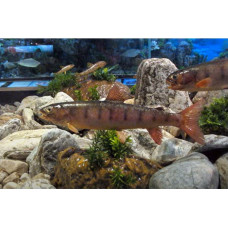From Ancient Greek βρᾰχύς μύσταξ "short upper lip".
The Lenok (Brachymystax) is a freshwater fish of the salmon family. The mouth is small. The maxillary ossicle does not reach the vertical of the posterior edge of the eye. On the body, dorsal and caudal fin scattered numerous dark spots. 1 genus with a single species. Inhabits the rivers of Siberia, there are in the Amur and rivers flowing into the Sea of Okhotsk and Sea of Japan. River fish. Matures at the age of 4-7 years. Spawning in May-June, on rocky-pebble soils at water temperature of 3-6°C. Fecundity is 2.5-8.0 thousand eggs. It feeds on insect larvae, crustaceans and fish, sometimes swallows mice, shrews, frogs. It is of local commercial importance.
Widespread in rivers and mountain lakes of Siberia and the Far East, China, Mongolia, as well as in Western Korea, not found west of the Urals. It prefers fast cold rivers, mainly their upper reaches. It stays in small flocks, large ones - alone. Reaches a length of about 70 cm and a weight of 6 kg. Cases of catching fish weighing up to 90 kg and three meters long are described. The growth rate is low.
Lenok is similar to whitefish in body shape. The body is bar-shaped, runny, the mouth is small with small sharp teeth, the scales are small, dense. Body coloration depends on habitat conditions, dark brown, on the back and sides with an abundance of dark rounded spots and golden plaque, light-colored in the abdominal part, in spawning season on the sides are red spots, upper, adipose and caudal fins in spots.
The Lenok inhabiting the river reaches has a silvery coloration with a dark gray back, fins with a yellowish cast. Lenok reaches sexual maturity in the fifth to eighth year of life at a length of 38 cm and a weight of 600-800 g. Females usually mature a year later than males. Spawning occurs in May-June, at a depth of 0.5-1.5 meters. Eggs are 4-4.5 mm in diameter and weigh 50-60 mg. The life span of the Lenk usually does not exceed 15 years. Predatory fish. Young Lenk feeds on zooplankton at an early age, and as it grows it switches to the consumption of bottom organisms - insect larvae (larvae of vernal caddisflies, mayflies, maggots, dragonflies, grasshoppers and other insects, gammarids, algae), bocoplaves, small mollusks, earthworms, eggs and young of other fish species (minnows, gudgeons, spruce gudgeons, podkamenschik, perch and grayling). Large lenoks sometimes ingest mice, shrews, frogs. The Lenok feeds at any time of the day, and is especially active in the morning and evening.
Spawning usually takes place in the upper reaches of small rivers, streams, and keys. When spawners come to the spawning grounds, they first of all clear the places where eggs are laid from silt and organic residues. Spawning of the Lenk begins, as a rule, in May, at water temperatures of 3-6 °C, rarely higher. Regardless of the geographical location of the water body, it is almost everywhere timed to the opening of a river or lake.
The Lenok spawns in areas with fast currents and rocky-pebble substrate, at a depth of about 1 meter. The number of eggs hatched is small and varies from 2.5 to 8 thousand. The eggs of the Lenok are the smallest of all salmonid fish and do not exceed 3 mm in diameter. The area occupied by lenk for spawning usually partially coincides with the spawning area of taimen. After spawning, the spawners remain in the spawning grounds for some time and then begin to move down to the lower, deeper sections of large rivers.
The incubation period usually does not exceed 20-30 days and depends on water temperature. The hatched larvae live for two weeks at the expense of the yolk sac reserve. Hiding under rocks, they lead a sedentary life. At one month of age, fry that have reached a length of more than 2 cm, actively feeding. During this period, small flocks of Lenk fry, sometimes together with grayling fry, fatten in the coastal strip, kuria and shallow bays of spawning rivers. In early fall, the young fish gradually roll into larger rivers, where they overwinter in deep channels.
The life span of the Lenk usually does not exceed 15 years. The largest specimens can reach a length of 89 cm and a weight of 6.4 kg. The usual size of the Lenk is not more than 35-40 cm, and the mass is 0.5-0.9 kg. The growth rate is low. By the age of 5, the lenok reaches a mass of 0.8 - 1 kg, and by the age of 10 - 2-3 kg.
Lenok
Tags: lenok




